As an Amazon Associate KitchenwareSets.com earns from qualifying purchases.
9 Secrets For The Perfect Apothecary Aesthetic Kitchen
Are you tired of scrolling through endless images of sterile, white-on-white kitchens that feel more like laboratories than the heart of a home? Do you crave a space with character, a touch of history, and a whisper of magic?
So many modern homes lean towards a stark, impersonal minimalism that can feel cold and uninspired. While clean lines have their place, they often lack the warmth, soul, and unique personality that makes a kitchen truly feel like your own. It’s easy to feel like you have to choose between modern functionality and old-world charm.
The apothecary aesthetic kitchen is a design style that draws inspiration from historic pharmacies and herbalist shops, blending vintage charm with practical functionality. It masterfully combines natural materials like dark wood and stone, highly organized storage in glass jars and labeled drawers, and a warm, enchanting atmosphere that turns your kitchen into a soulful sanctuary.
Craving a Kitchen with Soul? Here’s How to Unlock Old-World Charm
The apothecary aesthetic kitchen draws inspiration from historic pharmacies, blending vintage charm with functionality. It emphasizes natural materials like dark wood and stone, organized storage in glass jars and labeled drawers, and a warm, enchanting atmosphere reminiscent of herbalist shops. This design style is a direct response to the coldness of generic modern kitchens, offering a space that feels both personal and magical.
In my experience, the true beauty of this style is how it makes you feel. It’s not just a look; it’s an invitation to slow down, to connect with your ingredients, and to find a bit of enchantment in the everyday act of cooking. Inspired by the chemists and herbalists of the 17th to 19th centuries, this aesthetic transforms the kitchen into a room that tells a story—a place of creation, healing, and warmth.
But how do you capture that specific blend of scientific organization and whimsical charm? Here’s the deal: I’m going to share the secrets to creating this captivating space, from foundational design choices to the tiny details that bring the magic to life.
9 Secrets For The Perfect Apothecary Aesthetic Kitchen
To truly nail the apothecary aesthetic kitchen, you need more than just a few old bottles. It’s about a thoughtful curation of materials, lighting, and accessories that work together to create a cohesive and enchanting atmosphere. Think of it as mixing a potion; every ingredient is crucial.
I’ve distilled the essence of this style into nine actionable “secrets.” These aren’t just vague ideas; they are the specific design principles and atmospheric touches I’ve seen work time and time again. Following these will guide you in creating a kitchen that is not only visually stunning but also deeply functional and full of personality.
1. Secret: Master Authentic Cabinetry & Hardware
The best apothecary kitchens begin with cabinetry that feels authentic and historic, using materials like dark wood or deep, moody paint colors. The key is to incorporate many small drawers and finish them with vintage-style hardware, such as unlacquered brass or antique pewter, to capture the essence of a 19th-century pharmacist’s shop.
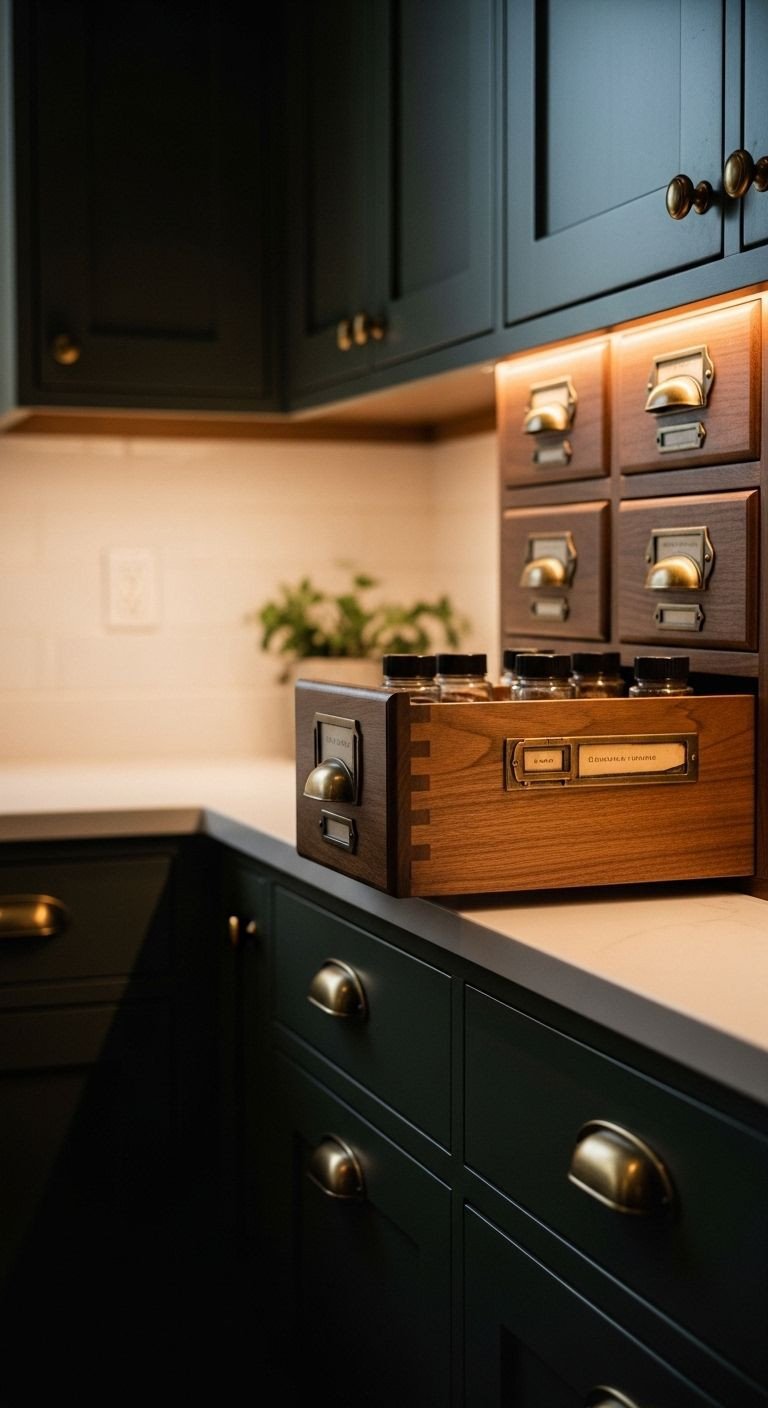
Materials Needed:
- Shaker-style cabinet doors
- Dark wood stain or deep moody paint (e.g., forest green, matte black)
- Vintage-style cup pulls or knobs (brass, bronze, or pewter)
- Label holders for drawers
- Fine-grit sandpaper
- Wood conditioner/primer
Step-by-Step Directions:
- Select Your Base: Choose dark wood cabinets (walnut, mahogany) for a rich, classic look. Alternatively, you can achieve a stunning effect by painting existing cabinets in deep, moody colors like forest green, matte black, or even a rich, creamy white. Shaker-style doors provide the perfect simple, historic silhouette.
- Incorporate Small Drawers: If a full renovation isn’t in the budget, focus on adding a freestanding apothecary cabinet with many small drawers. This can become a beautiful and functional focal point. You can also use drawer organizers within larger drawers to mimic the highly organized feel.
- Upgrade the Hardware: This is a high-impact, low-effort update. Replace any modern, sleek hardware with unlacquered brass, oil-rubbed bronze, or antique pewter cup pulls and knobs. The change is transformative.
- Add Labels: To fully commit to the theme, attach small metal label holders to your drawers. Use them for spices, teas, linens, or baking supplies. This small detail is the finishing touch that sells the entire aesthetic.
Pro Tip: Unlacquered brass is a “living finish” that will tarnish and patina over time, adding to the authentic, aged character of your kitchen. In my own projects, I’ve found that embracing this natural evolution is key. Don’t be afraid to let it evolve; that’s where the real charm lies.
Pin this cabinet idea for your dream kitchen inspiration!
2. Secret: Embrace Glass Jars & Open Shelving
The key to functional apothecary style is to use open shelving and glass jars to create curated, beautiful displays of everyday ingredients. By decanting items like spices, grains, and herbs into clear or amber glass jars, you turn practical storage into a stunning visual element that is both organized and decorative.
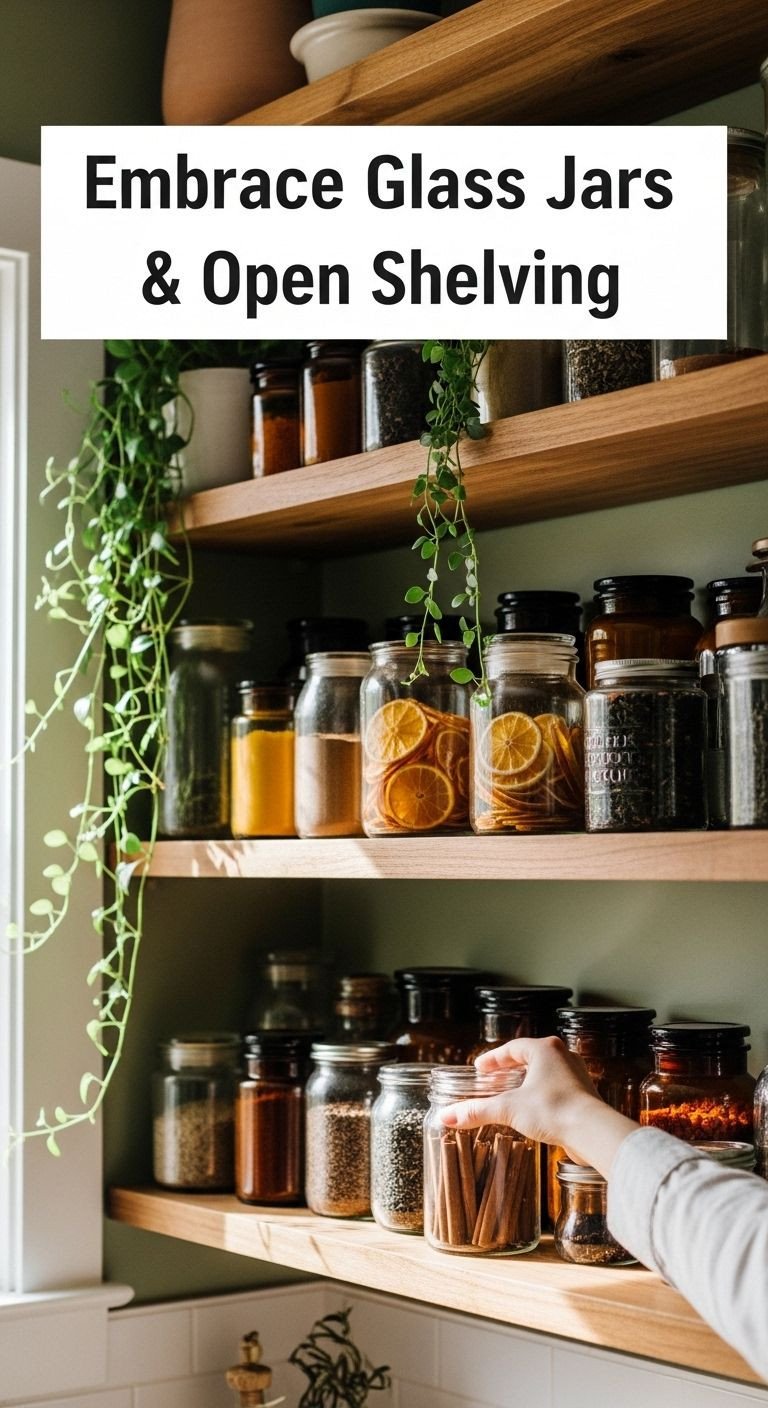
Materials Needed:
- Reclaimed wood planks or thick-cut lumber
- Heavy-duty shelf brackets (iron or brass)
- A collection of glass apothecary jars in various sizes
- A label maker or kraft paper tags and twine
- Dried goods (spices, herbs, pasta, beans, tea)
Step-by-Step Directions:
- Install Open Shelving: Mount thick, rustic wood shelves using sturdy, decorative brackets made of cast iron or aged brass. Position them in an accessible area, like over a countertop, for items you use frequently.
- Curate Your Jars: The hunt for jars is half the fun! Collect glass jars—both clear and amber work beautifully—with interesting stoppers like corks, glass lids, or metal caps. Consistency in style creates a cohesive look, but using varied sizes adds immense visual interest.
- Fill and Label: This is the satisfying part. Decant your dry goods like spices, lentils, pasta, loose-leaf teas, and dried herbs into the jars. Label each one clearly. You can use a vintage-style label maker for a clean look or simple handmade kraft paper tags tied with twine for a more rustic feel.
- Arrange with Intention: Group your filled jars by type or color. To break up the repetition, intersperse them with vintage dishware, small potted herbs, antique mortar and pestles, or a few beautiful cookbooks.
Lesson Learned: From my own experience setting up these shelves, the biggest mistake is creating clutter. The key is curation, not chaos. Only display items that are either genuinely beautiful or used on a daily basis. To keep things interesting, I rotate items seasonally—displaying dried orange slices in winter and bright chamomile in summer.
Love this organized look? See more storage ideas on our board!
3. Secret: Choose an Earthy, Muted Color Palette
The ideal apothecary kitchen color palette is built on a foundation of earthy, muted, and moody tones. Think deep forest greens, rich blues, matte black, and warm neutrals, which are then layered with natural materials like wood, soapstone, and marble to create a warm, historic, and inviting atmosphere.
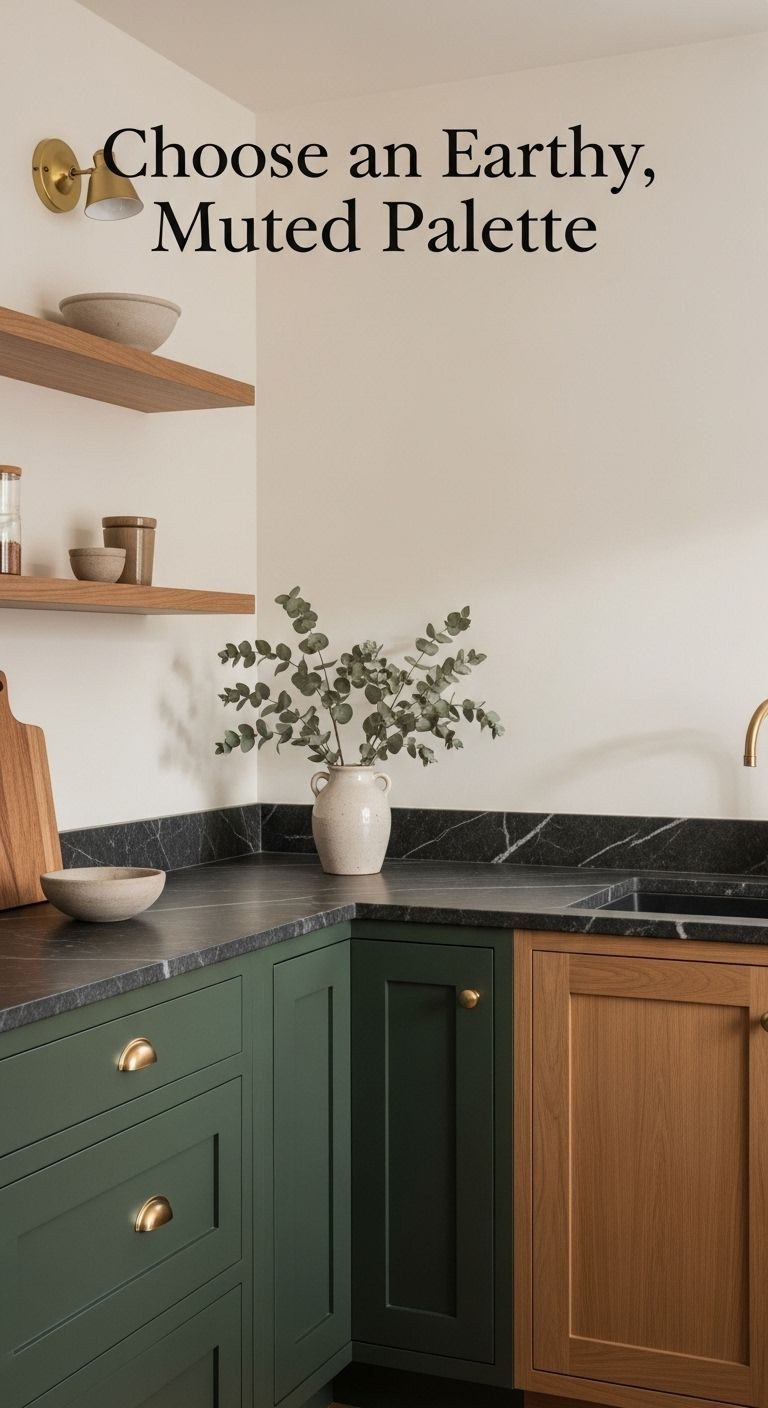
Materials Needed:
- Paint swatches in target colors (deep greens, blues, blacks, warm greys)
- Material samples (wood, countertop, tile)
- Mood board supplies (digital or physical)
Step-by-Step Directions:
- Start with a Foundation: Choose a primary, dominant color for your cabinets or a statement wall. Deep, moody greens (like Farrow & Ball’s “Studio Green”), rich navy blues, a soft matte black, or even a warm charcoal grey work beautifully as an anchor.
- Layer with Neutrals: It’s crucial to balance these deep colors to prevent the space from feeling overwhelmingly dark. Use warm neutrals like creamy off-white, soft beige, or a gentle taupe for walls, backsplashes, or trim. This contrast makes the deeper colors pop.
- Incorporate Natural Materials: This is where the texture comes in. Select countertops made of natural stone. Dark, veined soapstone or marble is classic. For flooring, consider reclaimed wood for warmth or vintage-inspired patterned tiles to add another layer of history.
- Create a Mood Board: Before you buy a single gallon of paint, collect samples! Gather your chosen paint swatches, hardware finishes, wood tones, and countertop samples. Lay them all out together to ensure they create a harmonious and cohesive palette that you love.
Pro-Tip: Always use a matte or eggshell paint finish instead of anything with a high gloss. A lower sheen is essential for this look. It absorbs light rather than reflecting it, which contributes to the soft, vintage, and slightly mysterious feel that is so central to the apothecary aesthetic.
Save this color palette to your kitchen design board!
4. Secret: Layer Warm, Moody Lighting
Creating the perfect atmosphere requires layering multiple sources of warm, dimmable light. This involves combining a statement fixture like a chandelier, functional under-cabinet task lighting, and soft accent lights to create a space that is both practical for cooking and enchantingly moody for relaxing.
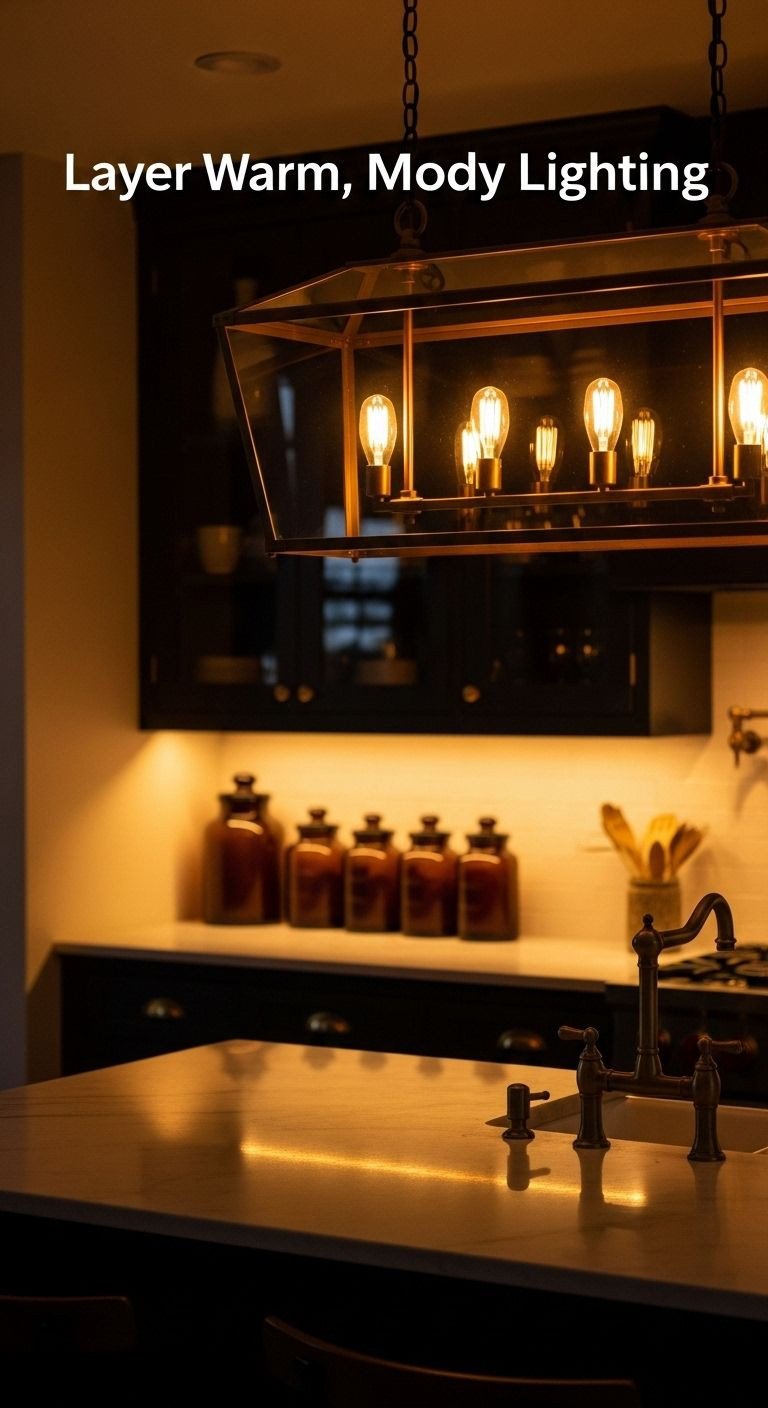
Materials Needed:
- Statement pendant or chandelier
- Under-cabinet LED light strips (warm white)
- Dimmer switches
- Task lamps (optional)
Step-by-Step Directions:
- Install a Statement Fixture: This is your room’s jewelry. Hang an antique-inspired brass chandelier or a set of industrial-style pendants over your kitchen island or main prep area. This serves as the visual centerpiece.
- Add Ambient & Task Lighting: Functionality is key. Install warm-white, dimmable LED strips under your upper cabinets. This is non-negotiable in my book. It perfectly illuminates your countertops for tasks like chopping while also highlighting your beautiful backsplash and displayed items.
- Incorporate Accent Lights: If you have glass-front cabinets, place small, directional spotlights inside. This turns your curated glassware or dishware into a softly glowing display and adds incredible depth to the room.
- Put Everything on Dimmers: This is the most crucial step for mood control. Install dimmer switches for all major light sources—your chandelier, pendants, and under-cabinet lights. This allows you to instantly shift the room’s feel from bright and functional for cooking to low, cozy, and magical for relaxing or entertaining.
Pro-Tip: When choosing your light bulbs, pay close attention to the color temperature. Look for a “warm white” rating, which is around 2700K (Kelvin). This rating produces a cozy, yellowish light reminiscent of candlelight. Avoid cooler bulbs (3500K and up), as their harsh, blue-toned light will completely undermine the vintage, moody vibe you’re working so hard to create.
Get inspired by this lighting look! Pin for later.
5. Secret: Accessorize with Purpose & History
The most authentic apothecary kitchens are accessorized with items that feel both purposeful and historic. Focus on finding vintage or vintage-inspired pieces that could have existed in a real pharmacy, such as balance scales, mortar and pestles, botanical prints, and an herb drying rack.
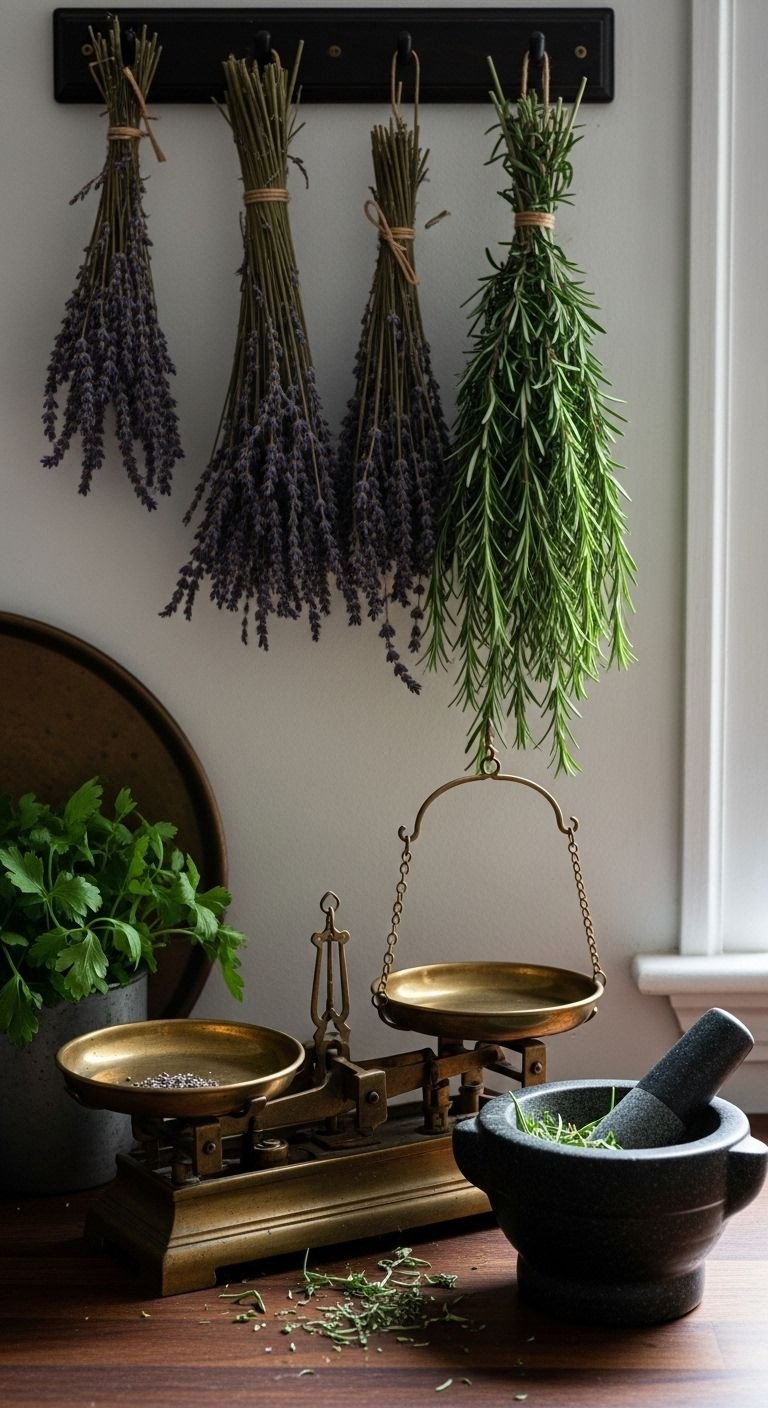
Materials Needed:
- Curated vintage finds (scales, tins, graters)
- Botanical art prints and frames
- An herb drying rack
- Small potted herbs (rosemary, thyme, basil)
- Linen tea towels
Step-by-Step Directions:
- Hunt for Vintage Treasures: Make flea markets and antique shops your best friend. Look for functional decor that tells a story—vintage balance scales, old wooden mortar and pestles, antique biscuit tins for storage, or even aged copper pots.
- Hang Botanical Art: This is a direct and elegant nod to the theme. Frame and hang a series of vintage-style botanical illustrations of medicinal plants and herbs. It adds a touch of scientific artistry to the walls.
- Install an Herb Drying Rack: This is both beautiful and incredibly practical. Mount a hanging rack from the ceiling or wall and use it to dry bundles of fresh herbs like lavender, rosemary, and sage. Their scent and appearance will add to the room’s sensory experience.
- Bring in Life with Plants: Nothing brings a kitchen to life like living things. Place small potted herbs like basil, mint, and thyme in rustic terracotta pots on your windowsills or countertops. They provide fresh ingredients and a necessary touch of vibrant green.
Lesson Learned: One thing I learned quickly is that the best accessories feel like they have a story. Choose items that look like they’ve been used and loved. Functionality is a great guide—a beautiful copper pot you can actually cook with is always better than a purely decorative knick-knack that just collects dust.
Want to find vintage decor? Pin this for your shopping list!
6. Secret: Cultivate the “Witchy” Vibe with Intention
To create a “witchy” kitchen aesthetic, you must infuse the space with personal intention and a connection to herbal lore. This is achieved by hanging dried botanicals for their symbolic meanings, understanding the folklore behind your ingredients, and practicing small, mindful rituals during the cooking process.
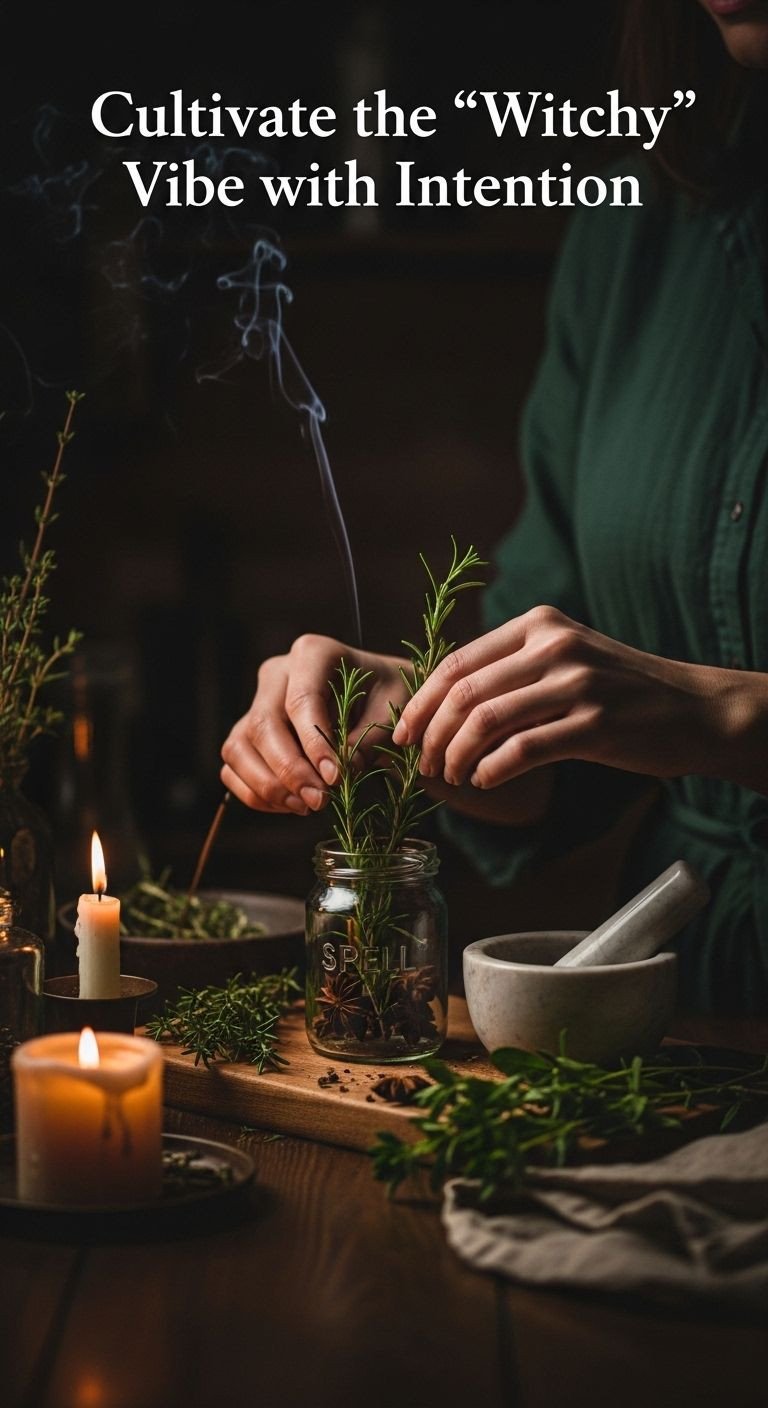
Materials Needed:
- Bundles of herbs (rosemary, sage, thyme)
- Small glass jars for “spell jars”
- A reference book on herbal symbolism
- Mortar and pestle
- Natural incense or candles
Step-by-Step Directions:
- Hang Dried Botanicals: Go beyond a simple drying rack. Hang bundles of herbs tied with twine in windows, from pot racks, or directly on the walls. Choose herbs based on their symbolic meanings—rosemary for remembrance and protection, sage for cleansing, lavender for peace.
- Learn Herbal Lore: Get a small, beautiful book on the folkloric or magical properties of common kitchen herbs. When you cook, you’ll know that basil can represent prosperity or that mint is for clarity. This adds a layer of intention to every meal.
- Practice Small Rituals: This is about mindfulness. As you cook, infuse your actions with intention. Stir your soup or sauce clockwise while thinking of positive things you want to draw into your home. Say a small, quiet blessing over your ingredients as you chop them.
- Create Kitchen “Spell Jars”: This is a beautiful, personal touch. Layer herbs, spices, and salts in small glass jars to represent intentions like protection, health, or happiness for your home. Place them discreetly on a shelf as a quiet guardian of your space.
Pro-Tip: In my experience, the “witchy” vibe is more about creating a personal connection and mindfulness than it is about overt decoration. The goal is to create a space that feels sacred and special to you. It’s about reconnecting with the ancient history of herbalism and the food you prepare.
Save this to your ‘Magical Home’ board!
7. Secret: Weave in Sustainable Practices
A core tenet of the apothecary aesthetic is to embrace sustainable and zero-waste practices that align with its historical roots. This means using refillable glass jars for bulk goods, swapping disposable plastics for cloth and wood, and composting food scraps, making the kitchen both beautiful and eco-conscious.
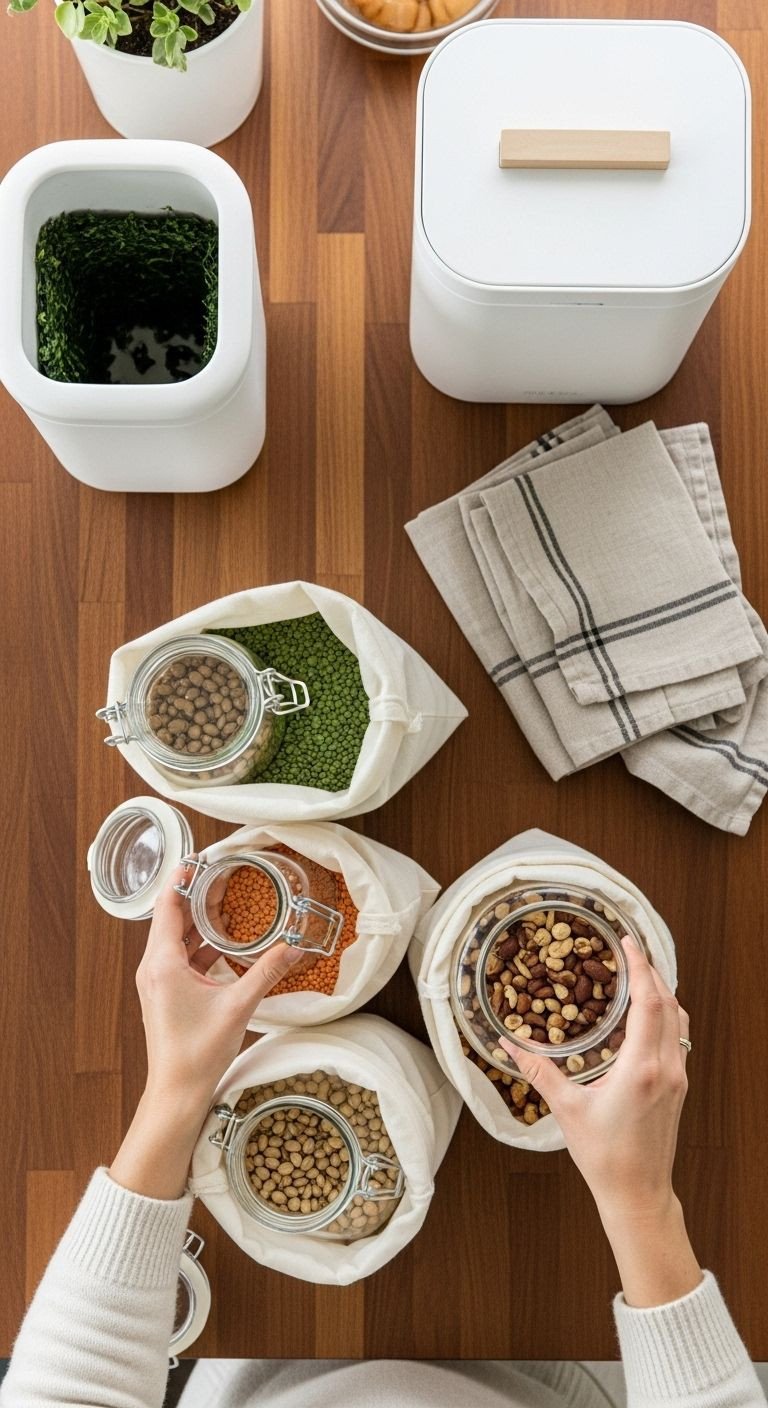
Materials Needed:
- Glass jars for bulk buying
- Cloth produce bags
- A countertop compost bin
- Reusable beeswax wraps or cloth bowl covers
Step-by-Step Directions:
- Embrace Bulk Bins: Take your beautiful collection of glass apothecary jars to stores that have bulk bin sections. Use them to refill your spices, grains, nuts, and flours. This is one of the most effective ways to eliminate single-use plastic packaging from your kitchen.
- Switch to Cloth: Make simple swaps. Use cloth produce bags for grocery shopping, elegant linen or cotton tea towels instead of paper towels, and reusable cloth bowl covers or beeswax wraps in place of plastic wrap.
- Start a Countertop Compost: Food scraps don’t have to be trash. Keep a stylish ceramic or metal compost bin right on your counter. It reduces waste significantly and provides you with nutrient-rich soil for your herb garden or houseplants.
- Choose Natural Cleaning Supplies: Complete the cycle by making your own simple, effective cleaners with vinegar, lemon, and essential oils. You can store them in beautiful amber glass spray bottles that fit the aesthetic perfectly.
Pro-Tip: What I love most about this is that the apothecary aesthetic is inherently sustainable. It celebrates durable, natural materials like wood, glass, and stone over disposable plastic. By leaning into this aspect, you’re not just designing a beautiful kitchen; you’re creating a responsible one.
Pin these tips for a beautiful, sustainable kitchen!
8. Secret: Marry Vintage Charm with Modern Tech
The secret to a functional apothecary kitchen is to cleverly integrate modern appliances while maintaining the vintage aesthetic. This can be done by hiding technology like dishwashers behind custom cabinet panels, choosing retro-inspired appliance designs, and using smart storage solutions within traditional-looking cabinets.
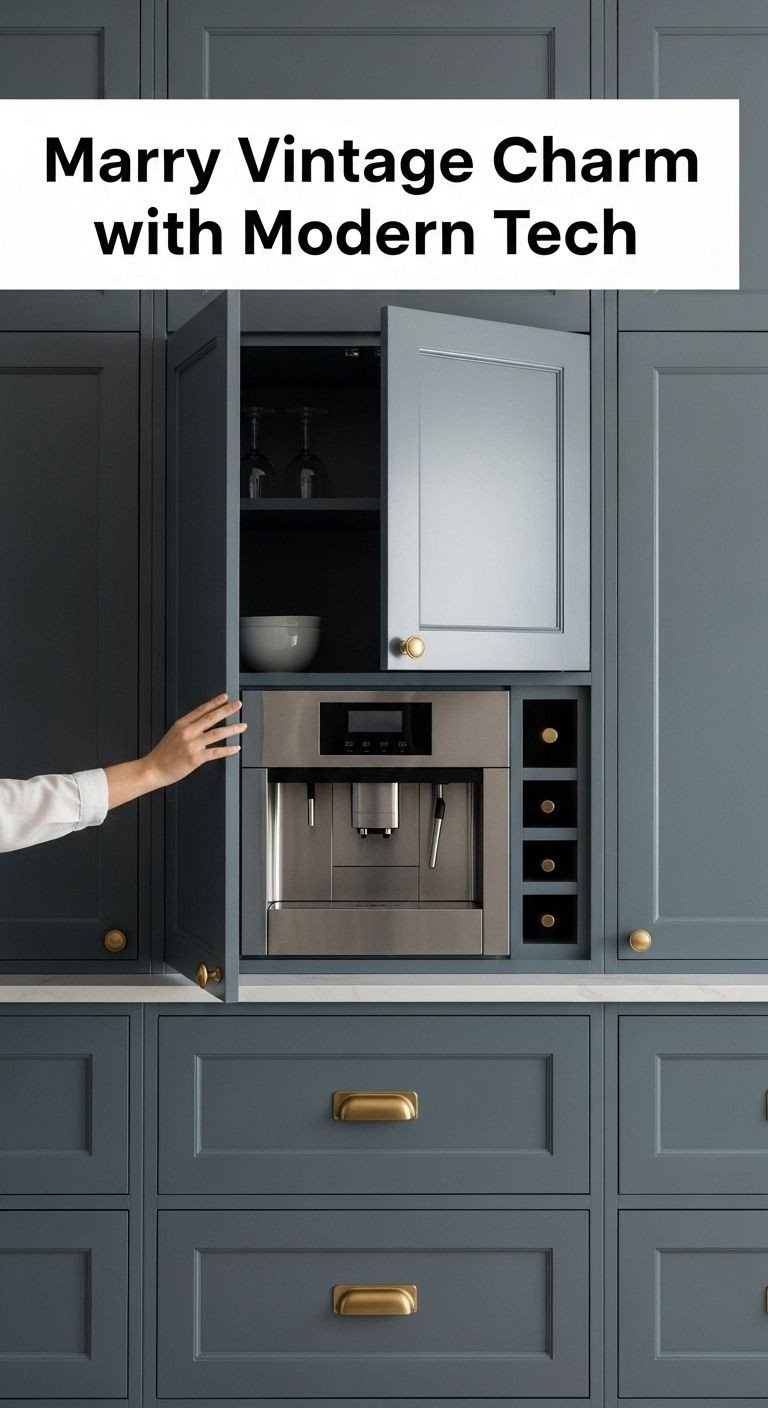
Materials Needed:
- Custom cabinet panels (appliance panels)
- Retro-style appliances
- Pull-out drawer organizers
Step-by-Step Directions:
- Conceal Appliances: The most seamless approach is to hide your modern dishwasher and refrigerator behind custom cabinet panels that perfectly match the rest of your kitchen. This creates an uninterrupted wall of beautiful cabinetry, preserving the historical illusion.
- Choose Retro Designs: If concealing isn’t an option, all is not lost! Opt for new appliances that are intentionally designed with a retro look. Brands like Smeg or Big Chill offer refrigerators and ovens in vintage styles and colors that can complement your palette.
- Integrate Smart Storage: The magic happens behind closed doors. Inside your beautiful vintage-style drawers and cabinets, install modern conveniences like pull-out spice racks, tiered pantry systems, and sleek drawer organizers. It’s the best of both worlds.
- Add Discreet Tech: You can still have modern luxuries. Incorporate subtle tech like a touchless faucet in an oil-rubbed bronze finish or a small, under-counter beverage fridge that’s hidden behind a matching cabinet door.
Lesson Learned: One thing I always tell my clients is that the goal isn’t to actually live in the 19th century; it’s to capture its beautiful aesthetic while enjoying all the convenience of the 21st. The most successful and livable designs are the ones that cleverly hide the modern elements that would break the spell.
Genius idea! Save this for your kitchen remodel.
9. Secret: Create a Full Sensory Experience
To truly complete the apothecary kitchen, you must go beyond visuals and intentionally engage all five senses. This involves layering natural aromas from herbs and spices, incorporating varied textures like wood and stone, curating a calming soundscape, and using the warm flicker of candlelight to create a fully immersive sanctuary.
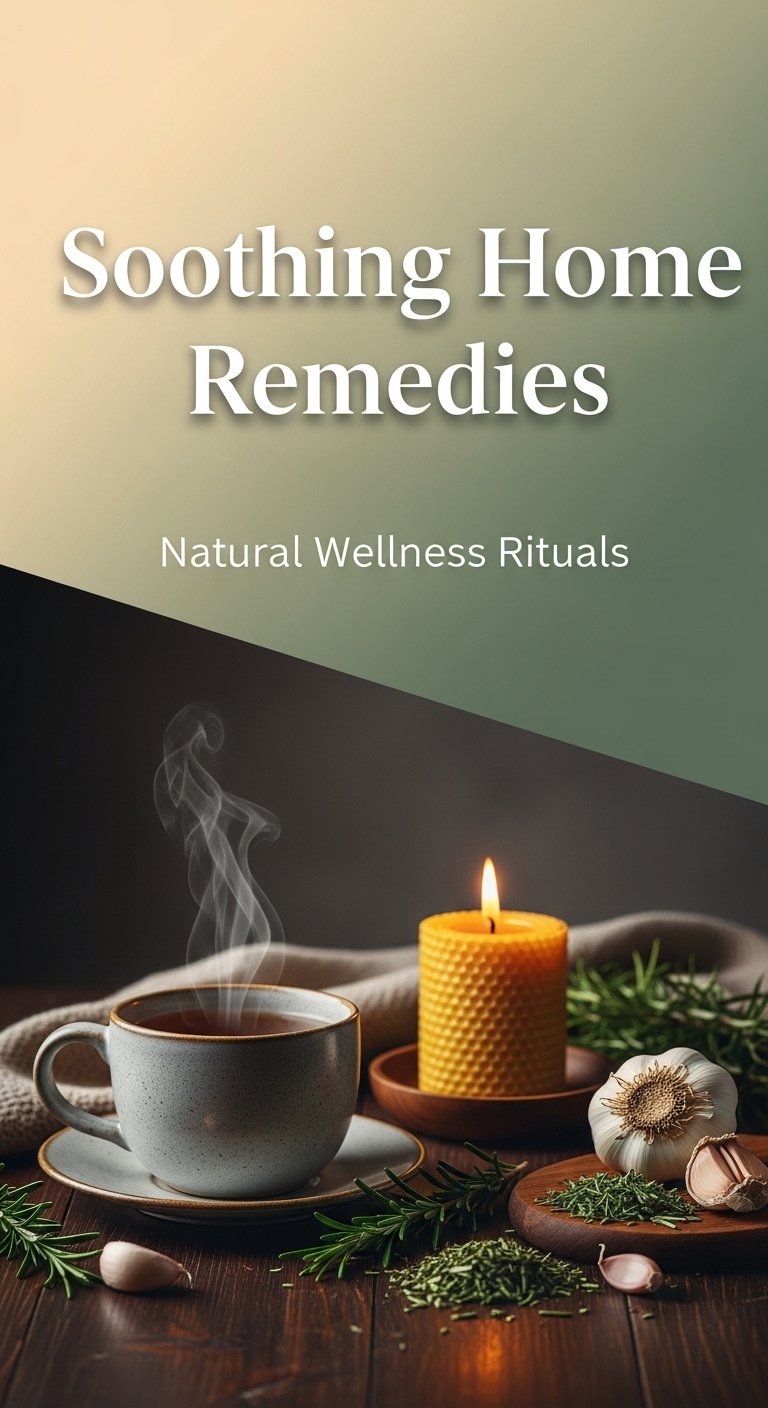
Materials Needed:
- Natural fiber textiles (linen, wool)
- Beeswax candles or an essential oil diffuser
- Bluetooth speaker
- Various natural materials (wood, stone, glass)
Step-by-Step Directions:
- Engage Smell: Let the natural, delicious aroma of your cooking be the primary scent. You can supplement this by gently simmering a pot of water with cinnamon sticks, cloves, and orange peels on the stove, diffusing earthy essential oils like cedarwood or frankincense, or lighting a natural beeswax candle.
- Engage Touch: Texture is everything. Actively incorporate a variety of natural textures that are a pleasure to touch: the smoothness of cool glass jars, the rough-hewn feel of reclaimed wood shelves, the cold, solid touch of a marble or soapstone countertop, and the soft, comforting weave of linen dish towels.
- Engage Sound: The sounds of a kitchen are part of its soul. Create a calming auditory environment by playing gentle instrumental music, a nature sounds playlist, or simply enjoying the organic sounds of cooking—the sizzle of food in a pan, the clinking of glass jars, the rhythmic chop of a knife.
- Engage Sight: Reinforce the visual mood you’ve built. Use the warm, flickering light of candles in the evening. Keep countertops intentionally clear of modern-day clutter like plastic packaging or mail, allowing the beauty of your curated items to shine.
Pro-Tip: The sensory experience is what transforms a kitchen from a “theme” into a true sanctuary. It’s the final, magical layer. In my own home, it’s the cumulative effect of these small details—the smell of simmering herbs, the feel of a heavy ceramic mug, the sound of quiet folk music—that makes the space feel genuinely special and restorative.
Pin this to create your own cozy kitchen sanctuary!
Key Takeaways: Your Quick Guide to the Apothecary Aesthetic Kitchen
Feeling inspired? Here is a quick summary of the most important steps to remember on your journey to creating the perfect apothecary aesthetic kitchen.
- Foundation First: Start with dark wood or moody-colored Shaker cabinets and authentic hardware like unlacquered brass. This sets the entire historical tone.
- Organize Beautifully: Use glass jars (clear and amber) and open shelving to turn the everyday storage of spices, herbs, and grains into a curated, beautiful display.
- Embrace the Vibe: Layer multiple sources of warm, dimmable lighting. Add purposeful vintage accessories like scales and mortar and pestles, and hang dried botanicals to create a cozy, “witchy,” and enchanting atmosphere.
- Blend Old & New: Don’t sacrifice modern function for style. Cleverly hide appliances like dishwashers behind custom panels or choose new appliances with retro-inspired designs.
- Engage All Senses: Go beyond just the visuals. A true apothecary kitchen incorporates natural textures, soothing sounds, and the rich, comforting aromas of herbs, spices, and good food cooking.
People Also Ask About Apothecary Aesthetic Kitchens
What is an apothecary kitchen?
An apothecary kitchen is a design style inspired by old-world pharmacies and herbalist shops. It features dark wood or moody colors, extensive organized storage like small drawers and glass jars, natural materials like stone and wood, and vintage decor. The goal is to create a space that is functional, charming, and full of character.
What do you put in apothecary cabinets and jars?
Apothecary cabinets and jars are perfect for organized, visible storage of everyday goods. Use the small drawers for loose-leaf teas, individual spices, coffee pods, or small baking supplies. Fill the glass jars with dry goods like pasta, rice, grains, beans, and flour, as well as more decorative items like dried herbs, citrus wheels, and whole spices like cinnamon sticks and star anise.
How can I get the apothecary look on a budget?
To get the look on a budget, focus on high-impact, low-cost changes. Start by painting your existing cabinets a deep, moody color and swapping out modern hardware for inexpensive vintage-style brass or bronze pulls. Scour thrift stores and flea markets for amber and clear glass jars and vintage decor like old scales or botanical prints. Installing a single floating shelf made of reclaimed wood is much cheaper than all-new cabinetry.
How is this different from a modern farmhouse kitchen?
While both can use natural materials, the apothecary aesthetic is moodier, darker, and more whimsical or magical. Farmhouse kitchens typically lean bright, airy, and rustic, with a heavy reliance on white paint, shiplap, and light woods. The apothecary style is more aligned with “dark academia” or “cottagecore,” embracing deeper colors, vintage scientific decor, and a slightly mysterious, enchanting vibe.
Final Thoughts
Creating an apothecary kitchen is so much more than following a design trend. It’s about intentionally crafting a space that reflects a love for history, nature, and the quiet magic of everyday rituals. It’s a declaration that the heart of your home should have a soul. By focusing on authentic materials, purposeful decor, and a rich sensory experience, you’re not just remodeling a kitchen; you’re building a sanctuary that will nourish both your body and your spirit for years to come.
Which of these secrets are you most excited to try in your own kitchen?
